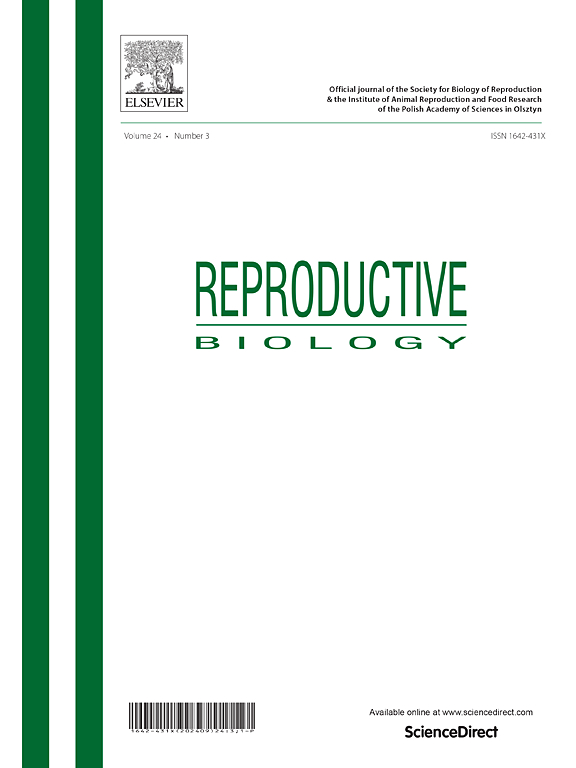The impact of extracellular glucose concentrations on antioxidant capacity, viability, and microRNA expression in TM4 Sertoli cells
IF 2.5
3区 生物学
Q3 REPRODUCTIVE BIOLOGY
引用次数: 0
Abstract
This study investigates the impact of extracellular glucose concentrations on antioxidant capacity, viability, and microRNA (miR) expression in TM4 Sertoli cell lines. TM4 cells were cultured in high-glucose (115 µm) and low-glucose (<505 µm) conditions to simulate hyperglycemia and glucose starvation, respectively. The study measured total antioxidant capacity (TAC), malondialdehyde (MDA), total oxidant status (TOS), glutathione (GSH), glutathione disulfide (GSSG), NADP/NADPH, glutathione peroxidase (GPX), and glutathione reductase (GR) levels. MiR-17, miR-34, miR-106a, and miR-200a expression levels were assessed. Cell viability and apoptosis were evaluated using MTT assay and acridine-orange staining. Results indicated that high glucose reduced miR-17 expression while low glucose increased it. Both glucose conditions elevated miR-34, miR-106a, and miR-200a expressions. TAC levels decreased, while TOS and MDA levels increased significantly under both conditions. High glucose had no significant effect on GPX and GR levels, whereas low glucose decreased them. Both conditions led to reduced GSH levels, increased GSSG levels, and altered NADP/NADPH ratio. Increased apoptosis and decreased cell viability were observed under both glucose conditions. These findings suggest that extracellular glucose levels significantly dysregulate miRNA expression, antioxidant capacities, and redox buffer systems in TM4 cells. High glucose conditions suppress miR-17 expression, increase miR-34 and miR-106a levels, and induce reductive buffer imbalance. Conversely, low glucose conditions trigger compensatory mechanisms via increased miR-17 expression to enhance antioxidant status while reducing GPX and GR levels. These results provide insights into the molecular responses of Sertoli cells under varying glucose environments, highlighting potential therapeutic pathways for conditions like diabetes and metabolic dysfunctions.
细胞外葡萄糖浓度对TM4支持细胞抗氧化能力、活力和microRNA表达的影响
本研究探讨了细胞外葡萄糖浓度对TM4支持细胞系抗氧化能力、活力和microRNA (miR)表达的影响。分别在高糖(115 µm)和低糖(505 µm)条件下培养TM4细胞,模拟高血糖和葡萄糖饥饿。研究测量了总抗氧化能力(TAC)、丙二醛(MDA)、总氧化状态(TOS)、谷胱甘肽(GSH)、谷胱甘肽二硫(GSSG)、NADP/NADPH、谷胱甘肽过氧化物酶(GPX)和谷胱甘肽还原酶(GR)水平。评估MiR-17、miR-34、miR-106a和miR-200a的表达水平。MTT法和吖啶橙染色法检测细胞活力和凋亡情况。结果表明,高糖降低miR-17的表达,低糖升高miR-17的表达。两种葡萄糖条件均升高miR-34、miR-106a和miR-200a的表达。在两种情况下,TAC水平均下降,而TOS和MDA水平均显著升高。高糖对GPX和GR水平无显著影响,低糖使其降低。两种情况都导致GSH水平降低,GSSG水平升高,NADP/NADPH比值改变。在两种葡萄糖条件下,细胞凋亡增加,细胞活力下降。这些发现表明,细胞外葡萄糖水平显著失调了TM4细胞的miRNA表达、抗氧化能力和氧化还原缓冲系统。高糖条件抑制miR-17表达,增加miR-34和miR-106a水平,并诱导还原性缓冲失衡。相反,低糖条件通过增加miR-17表达来触发代偿机制,从而增强抗氧化状态,同时降低GPX和GR水平。这些结果提供了Sertoli细胞在不同葡萄糖环境下的分子反应的见解,突出了糖尿病和代谢功能障碍等疾病的潜在治疗途径。
本文章由计算机程序翻译,如有差异,请以英文原文为准。
求助全文
约1分钟内获得全文
求助全文
来源期刊

Reproductive biology
生物-生殖生物学
CiteScore
3.90
自引率
0.00%
发文量
95
审稿时长
29 days
期刊介绍:
An official journal of the Society for Biology of Reproduction and the Institute of Animal Reproduction and Food Research of Polish Academy of Sciences in Olsztyn, Poland.
Reproductive Biology is an international, peer-reviewed journal covering all aspects of reproduction in vertebrates. The journal invites original research papers, short communications, review articles and commentaries dealing with reproductive physiology, endocrinology, immunology, molecular and cellular biology, receptor studies, animal breeding as well as andrology, embryology, infertility, assisted reproduction and contraception. Papers from both basic and clinical research will be considered.
 求助内容:
求助内容: 应助结果提醒方式:
应助结果提醒方式:


